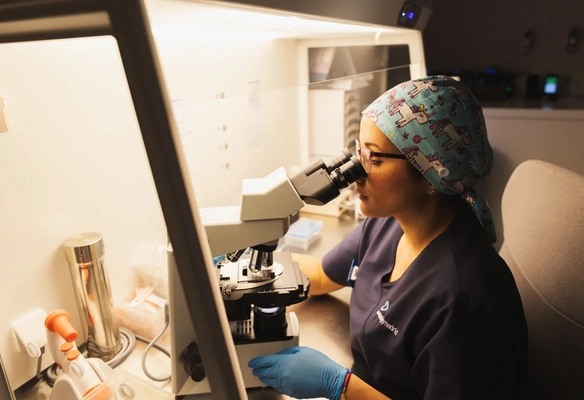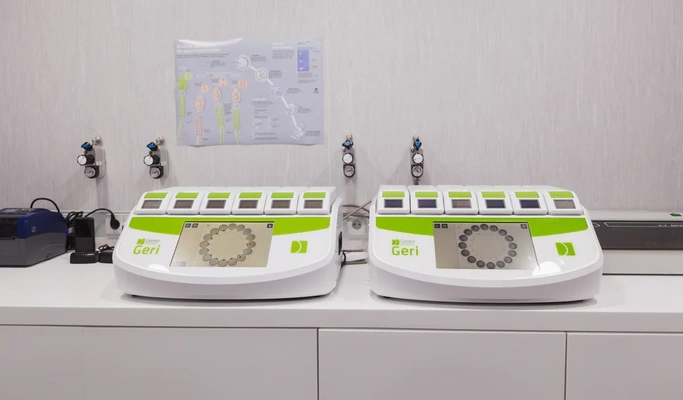Assignment of the code to each stage of the treatment.
Technology
Next-generation advances in assisted reproduction
At Fertility Madrid, we use cutting-edge technology to ensure maximum safety and effectiveness in fertility treatments. We have the GERI incubator, which allows real-time monitoring of embryo development, and the Gidget technology, an innovative traceability system that guarantees the correct identification of each sample. With these advances, we provide greater reliability and confidence throughout the entire treatment process.
GERI incubator: Advanced technology to improve embryo implantation
What is the GERI incubator and how does it work?
The GERI incubator is an embryo culture device that very precisely reproduces the conditions of the uterine environment. Thanks to its real-time image capture technology (Time-Lapse), embryologists can continuously observe the development of each embryo without removing them from the culture environment.
Each embryo is cultured in an independent chamber, reducing the risks of cross-contamination and allowing individual observation. This ensures greater stability during embryo development and facilitates the selection of the best embryos for transfer.
Benefits of the GERI incubator in fertility treatments
- Continuous embryo evaluation: Thanks to images captured every few minutes, much more complete information is obtained about the development of each embryo.
- Greater precision in selection: Allows more reliable identification of embryos with the highest implantation potential.
- Stable culture conditions: The environment inside the incubator is not disturbed, favouring more natural and safer embryo development.
- Reduced treatment time: By improving selection, pregnancy rates increase in fewer cycles.
- Non-invasive process: Embryos do not need to be removed for evaluation, which improves their viability.
Why choose Fertility Madrid?
At Fertility Madrid, we have one of the most advanced embryology laboratories in Spain. We use the GERI incubator in all our in vitro fertilisation treatments to guarantee the best possible results.
Our team of embryologists is highly qualified and in constant training. Thanks to our commitment to technology and personalised medicine, we are able to improve pregnancy rates and provide an experience centred on the patient’s wellbeing.

Gidget technology: smart traceability in your IVF treatment
What is Gidget and why is it important?
Gidget is an intelligent labelling system using QR codes, which allows all elements of the treatment to be registered: samples, patients, procedures, and professionals involved. Each step is electronically documented, which minimises the margin of human error.
How does the Gidget system work at Fertility Madrid?
Identification
Each sample receives a unique QR code.
Labelling
Electronic record
The “who”, “when”, and “what” of each procedure are recorded.
Automatic alert
Gidget detects inconsistencies and notifies the team.
Benefits of this technology for your peace of mind
- Extreme safety: prevents sample errors.
- Total transparency: every step is documented.
- Confidence and control: you can ask and verify your process.
- Constant innovation: demonstrating our investment in cutting-edge technology.
Frequently asked questions
What advantages does GERI have over other incubators?
GERI allows continuous observation without needing to open the incubator, which prevents changes in temperature and conditions. In addition, each embryo is cultured separately, improving traceability.
When is GERI used in an IVF treatment?
It is used from the moment the eggs are fertilised until the day of embryo transfer. This allows the entire development to be monitored.
Can it improve pregnancy rates?
Yes. By optimising embryo selection and maintaining ideal culture conditions, GERI contributes to a significant improvement in implantation rates.
Which samples are recorded with Gidget?
All of them: oocytes, sperm, and embryos.
How is the QR code generated?
It is assigned automatically when the sample arrives at the laboratory.
Can I ask to be informed of each step?
Yes. Your doctor or embryologist can update you on the process at any time.
Does Gidget replace current tests?
It does not replace medical checks. It complements them with electronic traceability.
From what age is it recommended to have a fertility study?
If you are under 35 and have been trying to conceive for a year without success, or six months if you are over 35, it is advisable to start a study. It is also useful if you want to know your ovarian reserve before planning a pregnancy.
At what point in the menstrual cycle are the tests carried out?
It depends on the test. Hormonal blood tests and the baseline ultrasound are usually done between days 2 and 5 of the cycle. Other tests, such as hysteroscopy, can be scheduled at any time indicated by the specialist.
Can I have the tests if I am taking contraceptives?
Yes, but some hormonal methods can alter certain results. Your doctor will advise whether it is best to stop them temporarily to obtain a more accurate assessment.
Are fertility tests painful?
Most are not. Ultrasounds and blood tests are painless or cause only mild discomfort. Procedures such as hysterosalpingography may cause discomfort similar to menstrual pain, but it is temporary.
Who interprets the results and how long do they take?
A specialist in assisted reproduction will review all the tests and explain the diagnosis to you. Most results are ready within a few days, although some more complex studies may take weeks.
What happens if low ovarian reserve is detected?
The doctor will explain the options depending on your age and situation: from trying to conceive naturally as soon as possible to undergoing assisted reproduction treatments or preserving eggs for the future.
